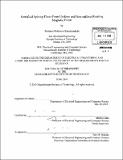Ferrofluid spin-up flows from uniform and non-uniform rotating magnetic fields
Author(s)
Khushrushahi, Shahriar Rohinton
DownloadFull printable version (232.4Mb)
Other Contributors
Massachusetts Institute of Technology. Dept. of Electrical Engineering and Computer Science.
Advisor
Markus Zahn.
Terms of use
Metadata
Show full item recordAbstract
When ferrofluid in a cylindrical container is subjected to a rotating azimuthally directed magnetic field, the fluid "spins up" into an almost rigid-body rotation where ferrofluid nanoparticles have both a linear and an angular "spin" velocity. Flow observations are often limited to the ferrofluid free surface due to the opaque nature of the ferrofluid and the surface flow can spin-up in the same or opposite directions to the direction of the rotating field. The mechanisms governing this flow have been attributed to surface driven flows that depend on the shape of the meniscus formed by the free surface. However, bulk flow experiments using ultrasound velocimetry show that even in the presence of a stationary cover, bulk ferrofluid flows would result when a rotating magnetic field was applied. The mechanisms explaining the bulk flows have been attributed by some authors to being a result of spin diffusion theory while others believe that non-uniform magnetic properties drive the flow, with both theories being rigorously explored in this thesis. This thesis applies ferrohydrodynamic analysis to extended fluid flow equations driven by magnetization forces and torques on the ferrofluid, Maxwell's equations relating magnetization, magnetic field and ferrofluid flow, and a Langevin magnetization relaxation constitutive law including the effects of fluid linear and spin velocities. Some key concepts investigated in this analysis are: (1) Ferrofluid filled cylindrical vessels of finite height placed within a uniform magnetic field result in non-uniform magnetic fields inside the ferrofluid due to demagnetization effects that can drive the flow; (2) A spherical vessel of ferrofluid in a uniform magnetic field has a resulting uniform magnetic field unless there is a spatial variation of magnetic properties, induced in this thesis by an external source of non-uniform magnetic field from a current carrying coil or a permanent magnet; and (3) COMSOL Multiphysics spin-diffusion modeling shows that spin viscosity can also initiate a flow due to spin-velocity boundary conditions which can hinder magnetic nanoparticle rotation near a wall or allow particles to roll along a wall due to flow vorticity. Ferrofluid spin-up flows were investigated that take into account demagnetizing effects associated with the shape of the container. The experiments conducted in this thesis involve using a sphere of ferrofluid in a uniform rotating field since a sphere has uniform and equal demagnetizing factors in all three Cartesian directions. The uniform rotating magnetic field is generated by two orthogonally placed spherical coils, known as "fluxballs" that generate a uniform magnetic field in the horizontal and vertical directions inside the fluxballs and a dipole field outside. By driving the coils with sinusoidal signals that are out of phase in time by 90 degrees a uniform rotating field is generated inside the test chamber containing the sphere of ferrofluid. The test sphere of ferrofluid is placed at the center of the larger surrounding "fluxball" machine. Negligible flows are measured within the ferrofluid filled sphere using ultrasound velocimetry in the "fluxball" machine with a uniform rotating magnetic field. COMSOL simulations using non-zero values of spin-viscosity, with a zero spin-velocity boundary condition at the outer wall, predict measurable flow while simulations setting spin-viscosity to zero result in negligible flow. Previously published values of spin-viscosity measured in cylindrical vessels are much larger than values allowed by kinetic theory because the flows, from which they were determined, are actually due to the demagnetizing field effects and not due to spin-diffusion. Experiments were also performed by partially filling the test sphere with ferrofluid but only 2/3 full, resulting in significant flows due to non-uniform magnetic fields from spatially dependent demagnetizing factors and possibly free surface effects. Ultrasound velocimetry measurements were also performed with a small permanent magnet or a DC/AC excited small coil on top of the ferrofluid filled test sphere, causing a nonuniform DC or AC magnetic field within the ferrofluid filled test sphere in addition to the uniform rotating magnetic field imposed by the fluxball coils. With an imposed non-uniform magnetic field component from magnet or coil, complex measurable flows with strong vortices are obtained. Formation of vortices is also confirmed in COMSOL simulations of an infinitely long cylinder subjected to a uniform rotating field and the field from an infinitely long permanent magnet. These measurements demonstrate that a non-uniform magnetic field or a non-uniform distribution of magnetic properties drive the flow. The spin-up ferrofluid flow in a rotating uniform externally applied field is highly dependent on the shape of the container due to demagnetizing effects. These demagnetizing effects in a finite-height ferrofluid filled cylindrical container create a non-uniform field inside the ferrofluid that drives the flow and is the cause for previously observed flows in the classic cylindrical spin-up flow experiments. COMSOL Multiphysics simulations applied to a cylinder of infinite height filled with ferrofluid show that spin-diffusion theory cannot be the dominant mechanism for spin-up flows as fitting the COMSOL analysis to measurements result in unphysically large values of spin viscosity. The unphysically large values of spin viscosity are obtained by attributing spin-up flow to be due to spin-diffusion alone rather than the correct non-uniform magnetic field effects. In conclusion, this thesis, through experimental results and numerical simulations, proves that non-uniform magnetic properties within the ferrofluid and not spin-diffusion theory is the driving mechanism for the measured flow.
Description
Thesis (Ph. D.)--Massachusetts Institute of Technology, Dept. of Electrical Engineering and Computer Science, 2010. Cataloged from PDF version of thesis. Includes bibliographical references.
Date issued
2010Department
Massachusetts Institute of Technology. Department of Electrical Engineering and Computer SciencePublisher
Massachusetts Institute of Technology
Keywords
Electrical Engineering and Computer Science.